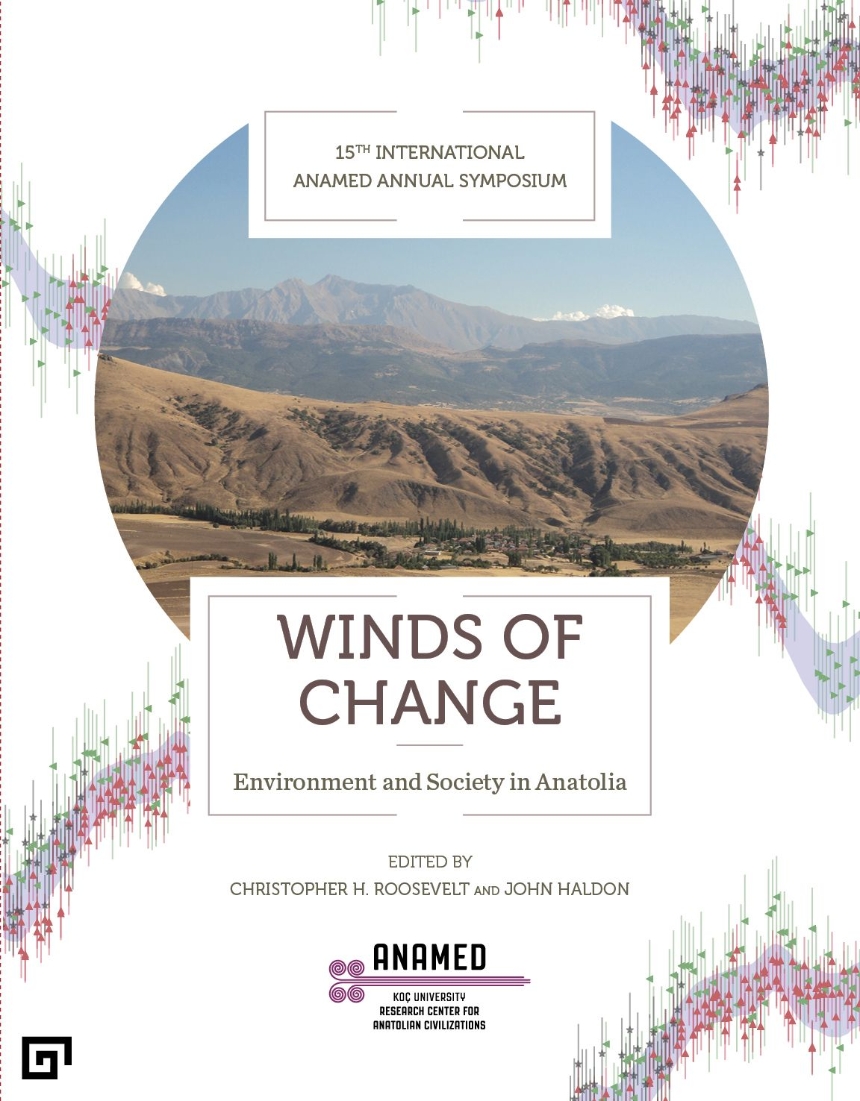Understanding the varied and dynamic interactions between environment and society in Anatolia.
In recent decades, the influences of environmental and climatic conditions on past human societies have attracted significant attention from both the scientific community and the general public. Anatolia’s location at the conjunction of Asia, Europe, and Africa and at the intersection of three climatic systems makes it well suited for the study of such effects. In particular, Anatolia challenges many assumptions about how climatic factors affect the socio-political organization and historical evolution, highlighting the importance of close collaboration between archaeologists, historians, and climate scientists.
Integrating high-resolution archaeological, textual, and environmental data with longer-term, low-resolution data on past climates, this volume of essays, drawn from the fifteenth International ANAMED Annual Symposium (IAAS) at Koç University’s Research Center for Anatolian Civilizations, showcases recent evidence for periods of climate change and human responses to it, exploring the causes underlying societal change across several millennia.
In recent decades, the influences of environmental and climatic conditions on past human societies have attracted significant attention from both the scientific community and the general public. Anatolia’s location at the conjunction of Asia, Europe, and Africa and at the intersection of three climatic systems makes it well suited for the study of such effects. In particular, Anatolia challenges many assumptions about how climatic factors affect the socio-political organization and historical evolution, highlighting the importance of close collaboration between archaeologists, historians, and climate scientists.
Integrating high-resolution archaeological, textual, and environmental data with longer-term, low-resolution data on past climates, this volume of essays, drawn from the fifteenth International ANAMED Annual Symposium (IAAS) at Koç University’s Research Center for Anatolian Civilizations, showcases recent evidence for periods of climate change and human responses to it, exploring the causes underlying societal change across several millennia.
Table of Contents
1. FRONTMATTER
a. Preliminary Pages
b. Table of Contents
c. Preface
d. Abbreviations
2. SECTIONS & CHAPTERS
a. Prologue
i. Boon or Curse? The Role of Climate Change in the Rise and Demise of Anatolian Civilizations (Neil Roberts) (5 figures)
b. Insights over the Long Term: Continuity & Change
i. An Assessment of Long-Term Climate Dynamics across Anatolia Based on the Results of Macrophysical Climate Modeling (Bülent Arikan) (11 figures)
ii. Early to Mid-Holocene Vegetation History and Human Settlement in Anatolia (Ceren Kabukcu, Eleni Asouti) (15 figures)
iii. Stability through Crisis: Cultural Resilience in the Face of Climatic Fluctuation from 3500 BCE to 1300 CE at Çadir Höyük in North-Central Anatolia (Madelynn von Baeyer, Tevfik Emre Serifoglu) (11 figures; 1 table)
iv. Genesis of the Beysehir Occupation Phase: Understanding the Socio-Environmental Systems of Anatolia and Interactions from Kültepe-Kanis and Paleoecological Records (Çetin Senkul, Mustafa Dogan, Aziz Ören, Fikri Kulakoglu, Warren John Eastwood, Ugur Dogan, Hugh Elton) (5 figures; 3 tables)
v. Assessing Continuity and Change in the Sixth to Ninth-Century CE Landscape of North-Central Anatolia (James Newhard, Hugh Elton, John Haldon) (12 figures; 2 tables)
c. Events, Landscapes, & People: Change & Response
i. Re-Thinking Thera: Tree-Rings, Radiocarbon, and Response in the Second Millennium BCE (Charlotte Pearson) (4 figures)
ii. The Justinianic Plague in Constantinople and Anatolia: A Reassessment of the Evidence (Lee Mordechai) (15 figures)
iii. Olive Cultivation at High Altitudes in Anatolia: Exploiting Micro-Localities in Ancient Asia Minor (Hugh Elton, Josh England, Anneley McMillian, Çetin Senkul, Patrick Free, Warren John Eastwood) (15 figures)
iv. The Environmental Consequences of the Coming of the Turks to Anatolia (Adam Izdebski) (2 figures)
v. Of Wetlands and Reclamation Regimes: Climate Change, Social Upheaval, and Political Practice in Western Anatolia (Semih Çelik, Christina Luke) (8 figures)
d. Epilogue
i. Environmental History and Archaeology in Anatolia: Concluding Comments and Prospects for the Future (John Haldon, Christopher H. Roosevelt) (4 figures)
3. BACKMATTER
a. Contributors
b. Index
a. Preliminary Pages
b. Table of Contents
c. Preface
d. Abbreviations
2. SECTIONS & CHAPTERS
a. Prologue
i. Boon or Curse? The Role of Climate Change in the Rise and Demise of Anatolian Civilizations (Neil Roberts) (5 figures)
b. Insights over the Long Term: Continuity & Change
i. An Assessment of Long-Term Climate Dynamics across Anatolia Based on the Results of Macrophysical Climate Modeling (Bülent Arikan) (11 figures)
ii. Early to Mid-Holocene Vegetation History and Human Settlement in Anatolia (Ceren Kabukcu, Eleni Asouti) (15 figures)
iii. Stability through Crisis: Cultural Resilience in the Face of Climatic Fluctuation from 3500 BCE to 1300 CE at Çadir Höyük in North-Central Anatolia (Madelynn von Baeyer, Tevfik Emre Serifoglu) (11 figures; 1 table)
iv. Genesis of the Beysehir Occupation Phase: Understanding the Socio-Environmental Systems of Anatolia and Interactions from Kültepe-Kanis and Paleoecological Records (Çetin Senkul, Mustafa Dogan, Aziz Ören, Fikri Kulakoglu, Warren John Eastwood, Ugur Dogan, Hugh Elton) (5 figures; 3 tables)
v. Assessing Continuity and Change in the Sixth to Ninth-Century CE Landscape of North-Central Anatolia (James Newhard, Hugh Elton, John Haldon) (12 figures; 2 tables)
c. Events, Landscapes, & People: Change & Response
i. Re-Thinking Thera: Tree-Rings, Radiocarbon, and Response in the Second Millennium BCE (Charlotte Pearson) (4 figures)
ii. The Justinianic Plague in Constantinople and Anatolia: A Reassessment of the Evidence (Lee Mordechai) (15 figures)
iii. Olive Cultivation at High Altitudes in Anatolia: Exploiting Micro-Localities in Ancient Asia Minor (Hugh Elton, Josh England, Anneley McMillian, Çetin Senkul, Patrick Free, Warren John Eastwood) (15 figures)
iv. The Environmental Consequences of the Coming of the Turks to Anatolia (Adam Izdebski) (2 figures)
v. Of Wetlands and Reclamation Regimes: Climate Change, Social Upheaval, and Political Practice in Western Anatolia (Semih Çelik, Christina Luke) (8 figures)
d. Epilogue
i. Environmental History and Archaeology in Anatolia: Concluding Comments and Prospects for the Future (John Haldon, Christopher H. Roosevelt) (4 figures)
3. BACKMATTER
a. Contributors
b. Index

